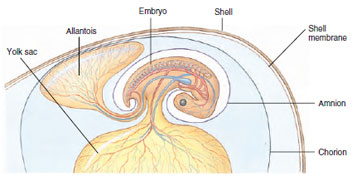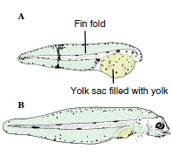Amniotes and the Amniotic Egg
Amniotes and the
Amniotic Egg
Reptiles, birds, and mammals form a
monophyletic grouping of vertebrates
called amniotes, so named because
their embryos develop within a membranous
sac, the amnion. The amnion is one of four extraembryonic membranes
that compose a sophisticated
support system within the amniotic
egg (Figure 8-20), which evolved
when the first amniotes appeared in
the late Paleozoic era. The shelled,
amniotic egg could be buried in nests
on land, thus freeing early amniotes
from the aquatic environment and
making possible unfettered conquest
of land by vertebrates.
Evolution of the first extraembryonic membrane, the yolk sac, actually predates appearance of the amniotes many millions of years. The yolk sac with its enclosed yolk is a conspicuous feature of all fish embryos. After hatching, a growing fish larva depends on the remaining yolk provisions to sustain it until it can begin to feed itself (Figure 8-21). The mass of yolk is an extraembryonic structure because it is not a part of the embryo proper, and the yolk sac is an extraembryonic membrane because it is an accessory structure that develops beyond the embryonic body and is discarded after the yolk is consumed.
The amniotic egg contains three extraembryonic membranes in addition to the yolk sac. The amnion is a fluidfilled sac that encloses the embryo and provides an aqueous environment in which the embryo floats, protected from mechanical shock and adhesions. The allantois is a sac that grows out of the hindgut and serves as a repository for metabolic wastes during development. It also functions as a respiratory surface for exchange of oxygen and carbon dioxide. The chorion lies just beneath the eggshell and completely encloses the rest of the embryonic system.
As the embryo grows and its need for oxygen increases, the allantois and chorion fuse to form the chorioallantoic membrane. This double membrane is provided with a rich vascular network connected to the embryonic circulation. Lying just beneath the porous shell, the vascular chorioallantois serves as a provisional “lung” across which oxygen and carbon dioxide can freely exchange. Thus the amniotic egg provides a complete lifesupport system for the embryo, enclosed by a tough outer shell. The amniotic egg is one of the most important adaptations to have evolved in vertebrate ancestry.
The evolution of a shelled amniotic egg made internal fertilization a reproductive requirement. A male must introduce sperm directly into the female reproductive tract, since sperm must reach and fertilize the egg before the egg shell is wrapped around it.
 |
| Figure 8-20 Amniotic egg at an early stage of evelopment showing a chick embryo and its extraembryonic embranes. |
Evolution of the first extraembryonic membrane, the yolk sac, actually predates appearance of the amniotes many millions of years. The yolk sac with its enclosed yolk is a conspicuous feature of all fish embryos. After hatching, a growing fish larva depends on the remaining yolk provisions to sustain it until it can begin to feed itself (Figure 8-21). The mass of yolk is an extraembryonic structure because it is not a part of the embryo proper, and the yolk sac is an extraembryonic membrane because it is an accessory structure that develops beyond the embryonic body and is discarded after the yolk is consumed.
 |
| Figure 8-21 Fish larvae showing yolk sac. A, The one-day-old larva of a marine flounder has a large yolk sac. B, After 10 days of growth the larva has developed mouth, sensory organs, and a primitive digestive tract. With its yolk supply now exhausted, it must capture food to grow and survive. |
The amniotic egg contains three extraembryonic membranes in addition to the yolk sac. The amnion is a fluidfilled sac that encloses the embryo and provides an aqueous environment in which the embryo floats, protected from mechanical shock and adhesions. The allantois is a sac that grows out of the hindgut and serves as a repository for metabolic wastes during development. It also functions as a respiratory surface for exchange of oxygen and carbon dioxide. The chorion lies just beneath the eggshell and completely encloses the rest of the embryonic system.
As the embryo grows and its need for oxygen increases, the allantois and chorion fuse to form the chorioallantoic membrane. This double membrane is provided with a rich vascular network connected to the embryonic circulation. Lying just beneath the porous shell, the vascular chorioallantois serves as a provisional “lung” across which oxygen and carbon dioxide can freely exchange. Thus the amniotic egg provides a complete lifesupport system for the embryo, enclosed by a tough outer shell. The amniotic egg is one of the most important adaptations to have evolved in vertebrate ancestry.
The evolution of a shelled amniotic egg made internal fertilization a reproductive requirement. A male must introduce sperm directly into the female reproductive tract, since sperm must reach and fertilize the egg before the egg shell is wrapped around it.




